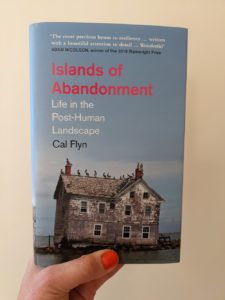Islands of Abandonment by Cal Flyn
Written by Ashley Kelmore, Posted in Reviews
Best for:
Readers interested in climate change, abandonment, natural disasters, and nature.
In a nutshell:
Author Flyn explores a variety of places across the world where humans have left a space – either because of their own damage, or natural disaster, or change in the way of living – and looks at how the earth renews itself, sometimes coming back stronger than before.
Worth quoting:
“We weed out plants well suited to the ground and conditions, and insist on propping up expensive, ill-suited, ornamental ones. Better, perhaps, to resist the impulse. Step back.”
“In an urban environment, entering an abandoned space is the nearest thing we have to stepping off the map.”
Why I chose it:
I find abandoned and/or remote areas to be really interesting. I’ve always lived in either dense suburbs (growing up) or major cities, so the idea of just … leaving an area to be reclaimed by the earth is hard to imagine. My partner spotted this book in a shop and I knew I would enjoy it.
Review:
What if you had to up and leave your home because of a volcano? Or a meltdown at a nuclear power plant? Or the creation of a buffer zone between warring nations? What if your home was slowly degraded, due to industry leaving it, or due to the poisoning of the area by the industry that you relied on for income? Or maybe the way of life you and your family grew up with changed, and you had to abandon your home on a tiny island?
Flyn explores all of these scenarios – and more – in her interesting and descriptive book. In all, she looks at a dozen different areas where humans once were. In a few, humans are still there, adjusting to a new way of living, but in most, people have had to leave, relinquishing the land to flora and fauna, who in many cases have made amazing and unexpected comebacks.
In one chapter, she looks at Ukraine and Chernobyl, which obviously retains a lot of radiation but not enough to necessarily kill many of the plants and animals that remain. In another, she explores a tiny island in Scotland, where the last family left nearly 50 years ago. A couple of buildings remain, but what’s most interesting are the many generations of domestic cattle that have slowly been returning to their wild roots.
As I have lived in densely populated areas my whole life (and generally choose that because I like, for example, being able to walk to the grocery store, not need a car, and have access to public transit), I find any large spaces no longer touched by humans to be fascinating. I picture the people who lived there, and then think how quickly it can change, sometimes through the actions of those very people, but sometimes completely outside their control. Especially in the chapters discussing post-war landscapes, I couldn’t help but think of the current conflicts going on around the world, and what is happening to the people being forced out, and what will happen to the places they once lived.
If we did 1/2 stars, I’d probably give it 3.5, but the topic and the way Flyn covers it caused me to round it up. My hesitation is that the writing is a bit flowery, in that the descriptions of the wildlife and vegetation are EXTREMELY detailed, to the point that for someone like me, who isn’t really knowledgeable of that topic, it all starts to blur together. I think some editing might have been beneficial here. But really that’s my only criticism.
Recommend to a Friend / Keep / Donate it / Toss it:
Recommend to a Friends and Keep

